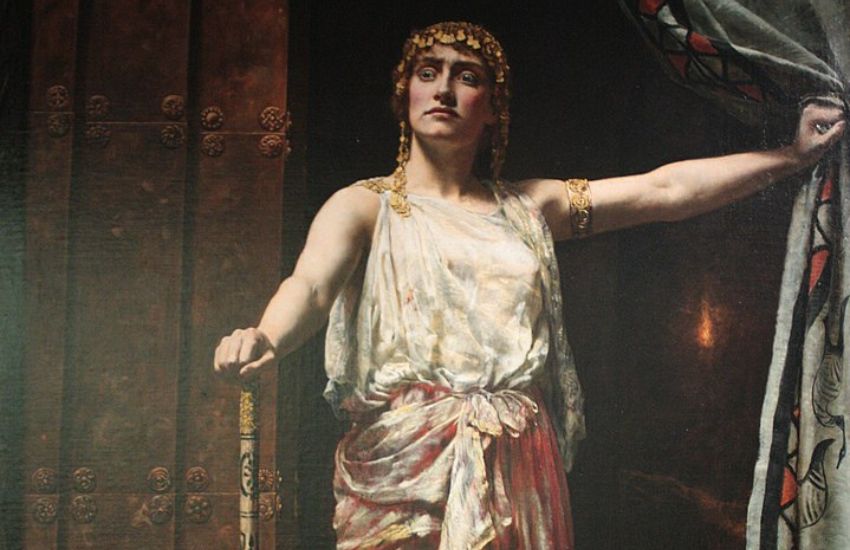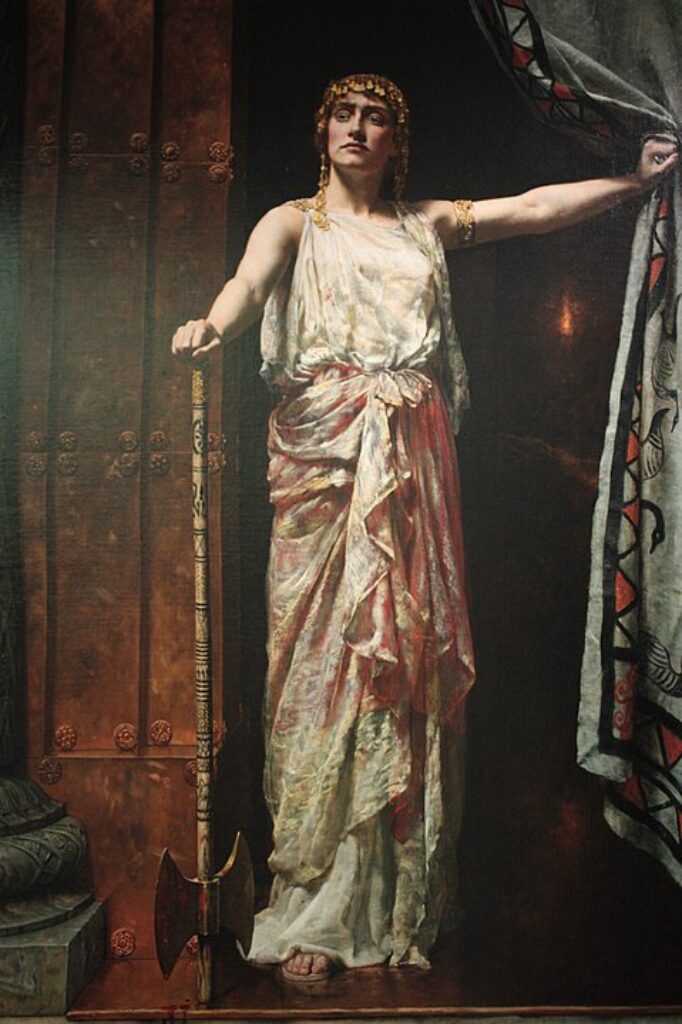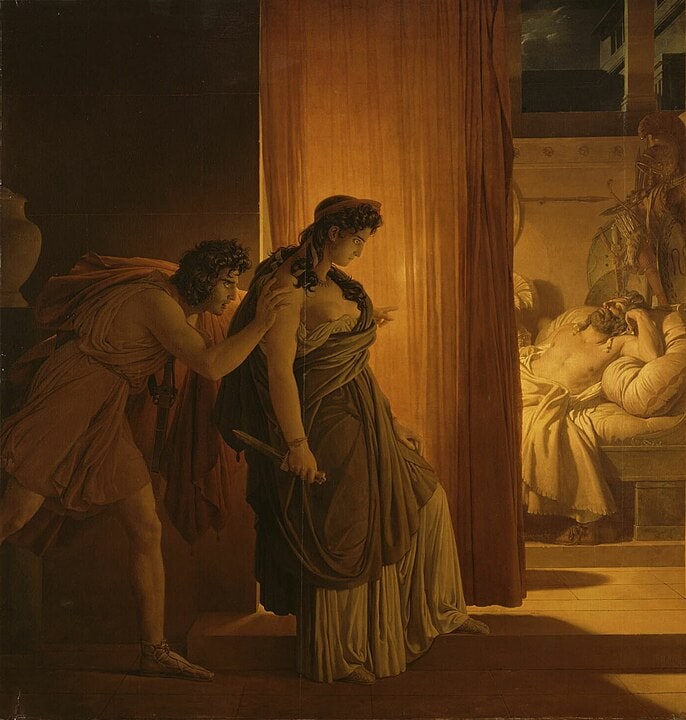
Table of Contents
Clytemnestra is an important figure in Greek mythology, known for her role in the murder of her husband, King Agamemnon and for the tragic events that followed. Her story is tragic and full of death and deceit. Although she herself was murdered, as a ghost she was took revenge on Orestes, her killer and son. But was Clytemnestra a victim or a perpetrator? Let’s take a closer look at her story.
Clytemnestra’s Origins and Myths

The Unusual Birth of Clytemnestra
Born in Sparta, Clytemnestra was one of the four children of Leda and Tyndareus, the king and queen of Sparta. According to the myth, Zeus slept with Leda in the form of a swan and she then became pregnant, and laid two eggs.
Each egg had two children. Castor and Clytemnestra were born from one egg, fathered by Tyndareus, while Helen and Polydeuces were fathered by Zeus. Thus, although they were siblings, they had completely different parentages, with two being mortal and the other two being demi-gods.
Clytemnestra and Agamemnon

According to the popular version, the brothers Agamemnon and Menelaus arrived in Sparta where they found sanctuary in King Tyndareus’ court. Tyndareus’ became so fond of Agamemnon that he gave his daughter Clytemnestra as his bride.
However, in another version, Clytemnestra was already married to a man called Tantalus and had a son by him, long before she met Agamemnon. Agamemnon saw Clytemnestra and decided that he wanted her to become his wife, so he killed her husband and her son and took her for himself.
Tyndareus wanted to have Agamemnon killed, but when he came to confront him, he found Agamemnon kneeling and praying to the gods. Surprised at Agamemnon’s piety, he decided not to kill him. Instead, he gave him Clytemnestra’s hand in marriage.
Clytemnestra and Agamemnon had four children, a son, Orestes, and three daughters, Chrysothemis, Electra and Iphigenia, who was Clytemnestra’s favorite.
The Trojan War and the Sacrifice
When Paris abducted Helen, wife of Menelaus and twin sister of Clytemnestra, Agamemnon, who was then the most powerful king in Greece, decided to help his brother bring back his wife and wage war against Troy. After all, their honor was at stake.
However, although Agamemnon had an army and 1000 ships ready to go, they were unable to embark on their journey due to stormy weather. Upon consulting a seer, Agamemnon was told that he would have to sacrifice his own daughter Iphigenia to appease Artemis, the goddess of the hunt. This would ensure success in the war so Agamemnon agreed and sent a note to Clytemnestra, deceiving her by asking her to bring Iphigenia to Aulis to be married to Achilles.
The Death of Iphigenia
Some say that when Clytemnestra and Iphigenia arrived in Aulis, Agamemnon told his wife what was to happen and terrified, she pleaded with Agamemnon for the life of her favorite daughter. Other sources say that Iphigenia was sacrificed in secret before Clytemnestra learned of her husband’s plans. As soon as Iphigenia was killed, favorable winds arose, making it possible for Agamemnon to leave for Troy with his army. Clytemnestra returned to Mycenae.
Clytemnestra and Aegisthus
With Agamemnon away fighting in the Trojan War for ten years, Clytemnestra began a secret affair with Aegisthus, Agamemnon’s cousin. She had reason to be angry at Agamemnon, as he had sacrificed their daughter. She may also have been angry at him because Agamemnon had slain her first husband and brought her to live with him by force. Together with Aegisthus, she began to plot revenge against her husband.
Agamemnon’s Death
When Agamemnon returned to Troy, some sources say that Clytemnestra gave him a hearty welcome. Then, when he tried to take a bath, she threw a large net over him and stabbed him with a knife. In other accounts, Aegisthus inflicted killing blows on Agamemnon and both Aegisthus and Clytemnestra committed regicide, meaning the killing of a king.
The Death of Clytemnestra

After the death of Agamemnon, Clytemnestra and Aegisthus were officially married and ruled Mycenae for seven years until Orestes, who had been smuggled out of the city previously, returned to Mycenae, seeking revenge on those who had killed his father. He killed Aegisthus and Clytemnestra even though she prayed and pleaded for her life.
Although she was killed, Clytemnestra’s ghost convinced the Erinyes, three goddesses known as avenging spirits, to persecute Orestes, which they then did. Orestes was pursued by the Erinyes (Furies) for this crime until he was eventually purified by Apollo and Athena.
Is Clytemnestra a Victim or Perpetrator?
There are arguments for both sides of this coin. It’s true that Clytemnestra had a difficult life because of some of her husband’s actions. For example, she lost her favorite daughter, a traumatic event that would well have driven her over the edge and caused her to carry out her later actions. She was also betrayed by Agamemnon, who in some versions of the myth brought Cassandra as a war prize and concubine. All this would have left Clytemnestra without a sense of agency and power, helpless in a man’s world.
However, on the other hand, she did engage in premeditated murder and planned to usurp power and her husband’s throne. In some accounts, she killed Cassandra, perhaps out of jealousy. If you have read our article on Cassandra, we’ve outlined how she was a woman who had been wronged and mentally tortured. Killing her for no good reason, except for being a war victim, shows a cruel and vengeful side of Clytemnestra.
It would be fair to say that while Clytemnestra committed heinous acts, she did so in response to personal betrayals and systemic wrongs. As such, she can be viewed as both a victim of her circumstances and a perpetrator of crimes.
Wrapping Up
Clytemnestra was one of the strongest and most aggressive characters in Greek mythology. According to the legends, her anger, although understandable, led to unfortunate consequences which affected the lives of everyone around her. While some say that she’s an unworthy role model, there are many who consider her a symbol of strength and power. Today, she remains one of the most famous tragic heroes in Greek mythology.
Related articles
The Titans: Primordial Powers of Greek Mythology
Echidna: Mother of Monsters in Greek Mythology
Cassandra: A Voice Ignored in Greek Mythology








